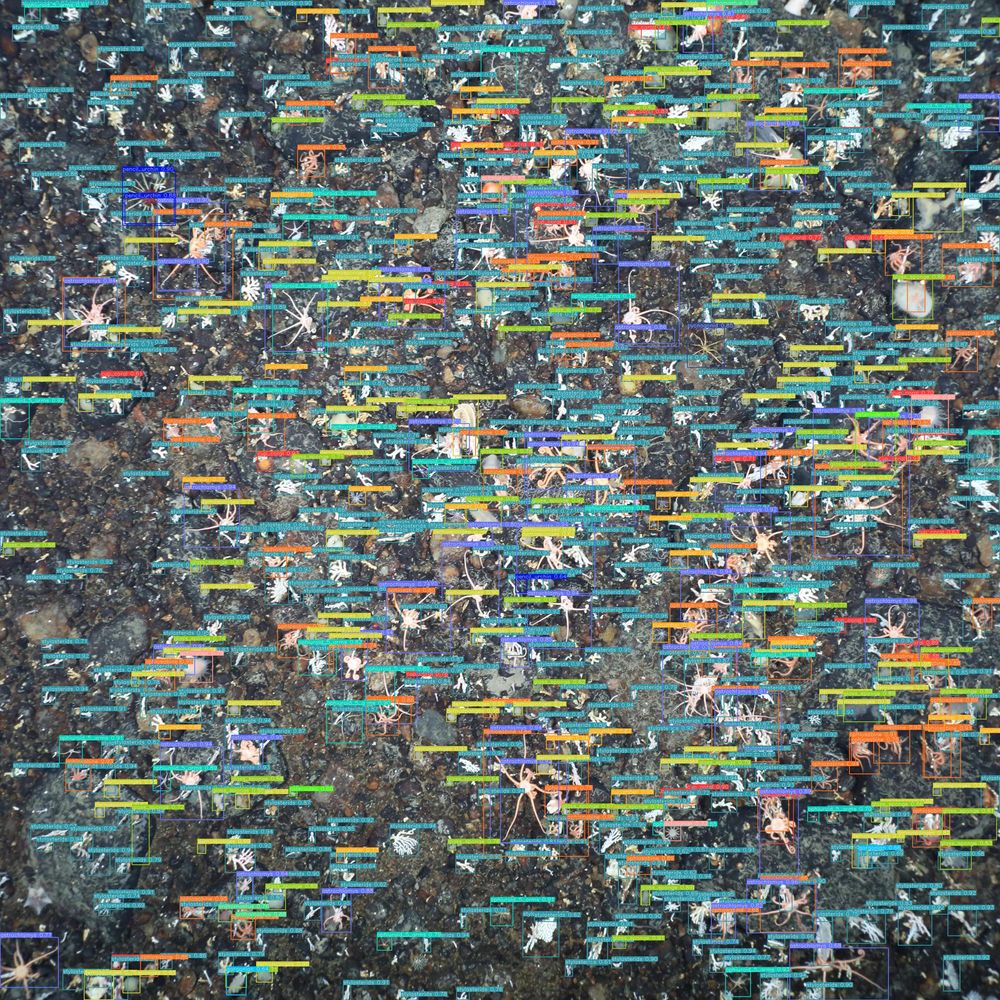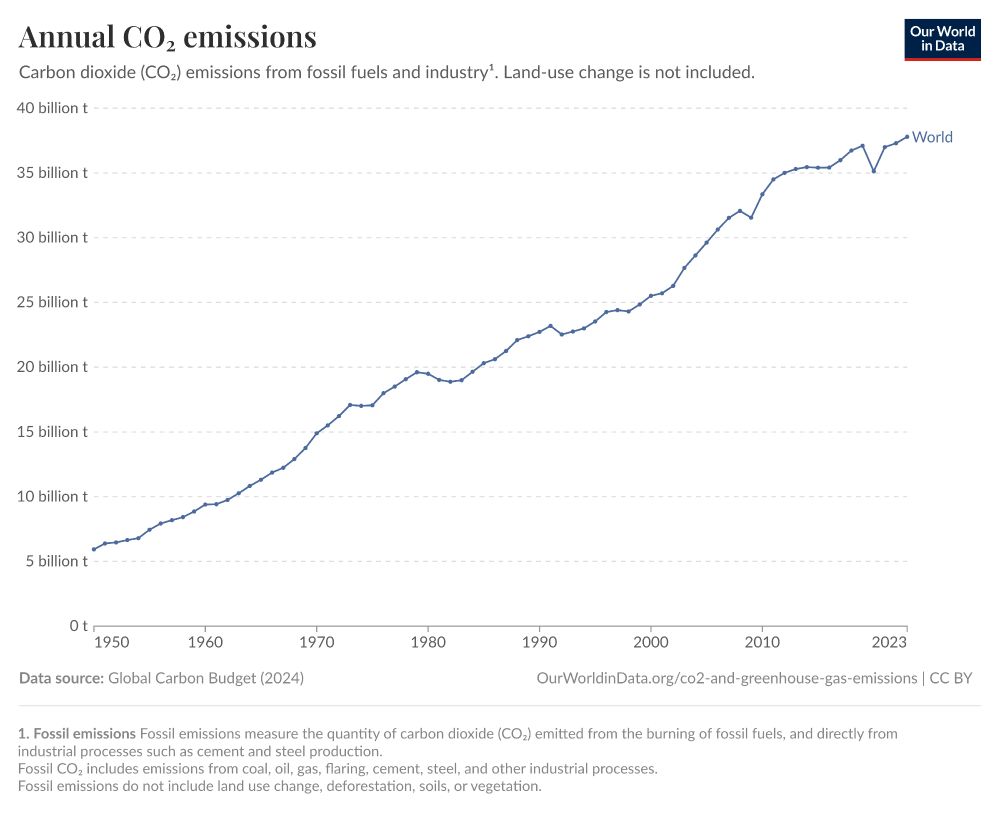Wayyyyyyy too long!
Below is an example of the kind of complex imagery we annotated, which went on to become part of the training dataset for the Antarctic seafloor project!
20.10.2025 17:33 — 👍 0 🔁 0 💬 0 📌 0
“Why didn’t you use AI to get the data” was the question I was asked most during my PhD.
There was no Antarctic dataset on which an AI model could learn. & it took me an average of 8 hours per photo to label everything.
@camerontrotter.bsky.social’s new model can do it in a matter of seconds.
20.10.2025 17:29 — 👍 1 🔁 0 💬 0 📌 0

An example output from our framework. An image of the Antarctic seafloor, with hundreds of organisms on it. The organisms each have a bounding box around them, a class label, and a confidence score produced by our framework.
🇦🇶 Our new paper detailing the automated detection of Antarctic benthic organisms using high-res in situ imagery has been accepted to the #ICCV2025 Joint Workshop on Marine Vision!
📄 Read the preprint now: arxiv.org/abs/2507.21665
🧵1/4
30.07.2025 15:50 — 👍 7 🔁 5 💬 1 📌 0
Photoshopping @lastweektonight.com John Oliver onto fossils until the Paleontological Research Institution secures their funding!
Fossil shell of the ammonite Grossouvrites sp. from the Cretaceous Lopez de Bertodano Fmt of Seymour Isl, Antarctica (PRI 60629). Comedian is H. sapiens. Not to scale.
12.07.2025 11:32 — 👍 27 🔁 4 💬 0 📌 1

A line chart titled “Annual CO₂ emissions” shows the global carbon dioxide emissions from fossil fuels and industry from 1950 to 2023. The y-axis represents emissions in billions of tonnes (t), ranging from 0 to 40 billion t. The x-axis covers the years from 1950 to 2023.
The chart presents a steady increase in emissions from approximately 5 billion tonnes in 1950 to over 36 billion tonnes in 2023. Key features include:
A consistent upward trend from 1950 through the early 1970s.
A brief plateau and dip around 1980–1983.
A strong growth trend resuming in the late 1980s.
A sharp increase during the 2000s.
A slight drop around 2008–2009, likely due to the global financial crisis.
A major dip in 2020, attributed to the COVID-19 pandemic.
A rapid rebound in emissions after 2020, continuing the upward trend to a new high in 2023.
A blue line labeled “World” traces these changes over time.
Below the chart, the data source is listed as the Global Carbon Budget (2024), and the graphic is credited to OurWorldInData.org with a Creative Commons license (CC BY). A footnote explains that the data includes emissions from coal, oil, gas, flaring, cement, and steel, but excludes land-use changes such as deforestation.
I get annoyed at the narrative that all the awareness and work on climate change hasn't done anything. Yes, global CO₂ emissions indeed continue to climb, but we don't know the counterfactual. When I was in grad school, we were on track for 5°C of warming. Now it's below 3°C. That's progress.
22.06.2025 17:09 — 👍 2006 🔁 448 💬 77 📌 40
Lots of Earth System Modelling (🌍ESM) jobs up for grabs at @bas.ac.uk!
🫧 ESM - Past Carbon Cycle (w/ me and Xu Zhang)
🇦🇶 ESM - Antarctic Sea Ice
🌡️ ESM - Past Extremes
🧊 UKESM Sea Ice Model Developer
💧Research Assistant: Palaeoclimate Meltwater Modelling
www.bas.ac.uk/jobs/vacanci...
23.06.2025 13:50 — 👍 2 🔁 3 💬 0 📌 0
Photoshopping John Oliver onto fossils until the Paleontological Research Institution secures their funding!
Section of fossil tree fern, Tempskya wesselli, from the Cretaceous of Idaho. Comedian is H. sapiens. Not to scale.
25.05.2025 14:30 — 👍 42 🔁 8 💬 0 📌 3
@egmitchell.bsky.social @huwiceandstuff.bsky.social @rowanwhittlebas.bsky.social @camzoology.bsky.social @bas.ac.uk @newnhamcollege.bsky.social @awi.de
24.05.2025 15:55 — 👍 1 🔁 0 💬 0 📌 0
However, the pink morph exhibits dispersal plasticity, and is able to increase its dispersal distances, when in competition with the pink morph in mixed communities, increasing alpha diversity.
Coauthors Huw Griffiths, Nile Stephenson, Rowan Whittle, Autun Purser, Andrea Manica & Emily Mitchell.
24.05.2025 15:54 — 👍 1 🔁 0 💬 1 📌 0

Furthermore, we discovered that coexistence of the pink and orange morphs is due to inter-morph competition, with the orange morph emerging as the stronger competitor, maintaining its reproductive behaviour across all community types.
24.05.2025 15:51 — 👍 1 🔁 0 💬 1 📌 0

Using Spatial Point Process Analysis, a method borrowed from forest ecology, we discover that limited dispersal, rather than environment, structured the spatial arrangement of the cup corals. Dispersal limits of 6-10 cm suggests these cup corals are likely brooders, which produce crawl-away larvae.
24.05.2025 15:50 — 👍 2 🔁 0 💬 2 📌 0
We ask two questions: what processes drive the spatial distribution of Antarctic epibenthic communities at centimeter scales, which has largely been put down to “unknown biological factors”? Second, how do two, apparently very ecologically similar morphs coexist on the Powell Basin?
24.05.2025 15:49 — 👍 1 🔁 0 💬 1 📌 0

In in-situ seabed photos, they are only distinguishable by the colour of their tentacles, so we term them the “pink” and “orange” morphs. The corals form mixed communities and single population dominant communities, where either morph is near-absent.
24.05.2025 15:48 — 👍 2 🔁 0 💬 1 📌 0

New paper alert! 🚨
rdcu.be/entY4
In the second paper of my PhD, published today in Scientific Reports, we investigated the spatial ecology of two solitary scleractinian coral morphotoypes, which are likely Caryophyllia or Flabellum, from the Powell Basin slopes of Antarctica 🇦🇶 .
24.05.2025 15:48 — 👍 17 🔁 3 💬 1 📌 0
Thank you so much!
14.05.2025 13:55 — 👍 1 🔁 0 💬 0 📌 0
What a crazy last few days… passed my PhD viva on Friday, and just 20 mins ago, the second paper from my PhD just got accepted in Scientific Reports! Woohoo! 🥳
12.05.2025 10:25 — 👍 3 🔁 0 💬 0 📌 0
Thank you so much for joining! And suggesting we facilitate Zoom attendance!
09.05.2025 22:43 — 👍 1 🔁 0 💬 1 📌 0
PhDone!!! Passed my viva with minor corrections!
Thanks to @egmitchell.bsky.social @huwiceandstuff.bsky.social @rowanwhittlebas.bsky.social and Andrea Manica for supervising, and Prof Rob Fletcher and @dralexdunhill.bsky.social for examining!
09.05.2025 22:17 — 👍 30 🔁 4 💬 1 📌 0

Great first day at my new postdoc: jumping off at the deep end with a workshop on AGELESS and BioDeepTime at FAU Palaeo. Will be presenting my PhD work tomorrow as part of the public talks for the meeting.
01.04.2025 15:12 — 👍 7 🔁 1 💬 0 📌 0
@fossilsndcoffee.bsky.social I will email you and friends once the viva date has been scheduled!
22.03.2025 12:46 — 👍 1 🔁 0 💬 0 📌 0
So we don’t typically have a public defense, just an oral exam with two examiners. The department encourages a pre-viva talk but it’s not usually done - I however, hope to do so! In which case I will opt for hybrid!
22.03.2025 12:46 — 👍 1 🔁 0 💬 1 📌 0
Thank you Brendan!!
21.03.2025 15:40 — 👍 1 🔁 0 💬 1 📌 0
Yay! 😁😁😁
21.03.2025 12:13 — 👍 1 🔁 0 💬 0 📌 0
My thesis was very kindly supervised by the wonderful @egmitchell.bsky.social , Andrea Manica, @rowanwhittlebas.bsky.social and @huwiceandstuff.bsky.social , based out of @camzoology.bsky.social, the Museum of Zoology and the British Antarctic Survey!
20.03.2025 21:09 — 👍 5 🔁 0 💬 0 📌 0


I submitted my PhD! Titled “Quantitative ecology reveals scale-dependent structural processes of the Antarctic benthos through time” - in 3.5 years I have 1 paper out (benthic ecosystem function), 1 in 2nd round of review (on competition between coral morphs) and a 3rd in the 1st rounds of review.
20.03.2025 21:07 — 👍 18 🔁 2 💬 2 📌 2

Social media can help track species as climate changes
Social media can help scientists track animal species as they relocate in response to climate change, new research shows. The “range” inhabited by many species is shifting, and this is mostly tracked ...
Social media can help scientists track animal species as they relocate in response to #climatechange, new research shows
Full study here 👉 onlinelibrary.wiley.com/doi/10.1002/...
Read our press release below 👇
@nis38.bsky.social @pettorelli.bsky.social @uniexecec.bsky.social @exeter.ac.uk
13.03.2025 10:00 — 👍 3 🔁 2 💬 0 📌 0

Greetings from the Maldives! Husband & I are on last day of honeymoon, we snorkeled with giant manta rays this morning & when we got back, I submitted the third paper from my PhD! Slightly ironic to submit an Antarctic paper from here but Cretaceous Antarctica was hot anyway, so maybe I’m on brand.
14.01.2025 11:59 — 👍 0 🔁 0 💬 0 📌 0
very cool, congratulations! Looking forward to reading it!
13.12.2024 22:11 — 👍 1 🔁 0 💬 1 📌 0
Thank you, Liz!!
12.12.2024 15:58 — 👍 0 🔁 0 💬 0 📌 0
Ecologist using #insectcollections to understand long-term #biodiversitychange and inform #conservationaction
Henslow Fellow @ Darwin College, Gibbs Travelling Fellow @ Newnham College based in Insect Ecology Group & Museum of Zoology (UniofCam).
We're the UK's polar research institute 👋 Uncovering the secrets of Earth's frozen places, doing science for a sustainable planet.
Looking for a seriously remote job? https://bas.ac.uk/vacancies
A virtual seminar series covering research on population biology and theoretical ecology from the Asia-Pacific. We meet the last Thursday of every month at 1pm AEST, UTC+10. Subscribe to our seminar announcements: https://forms.gle/t8z3DNzb4Sga19v68
Professor of Ecosystem Data Science at @hifmb.bsky.social studying the ecology and evolution of microbes through high-resolution 'omics and #anvio
Simplifier of things. bridgewalker. Island-person. Nets and Complexity. Prof of Biodiversity Theory. Former Prof. of Computer Science, Reader in Eng. Maths. Once a Physicist. Interested in art and language and generally making the world a better place.
Molecular Ecology, Evolution, Conservation - Corals; Professor of Marine Conservation at the Helmholtz Institute for functional marine biodiversity
Associate Professor, Bristol University 🧪
Resilience loss ⚖️ Early warning signals ⚠️ multiple stressors 🏭 biodiversity change 🌍 rewilding 🦫
🔗 experimentalconservation.com
Editor at Biology Letters.
Paleobiologist 🦴, Software Engineer 💻, and Open Scientist 🔍
Postdoctoral Researcher at Syracuse University (He/Him)
Scientist, marine community ecology, biodiversity change, phytoplankton
Works at University of Oldenburg and @hifmb.bsky.social.
Jazz aficionado
he/him
Views my own
Artistic Autistic Angel fanatic. I have no idea what I’m doing.
Come for the Magic, stay for the Octopus facts. Also sometimes I draw things??
Welcome!
🏳️🌈
she/her
Research Fellow @eegcam.bsky.social & Emmanuel College, Cambridge University 🍃| Former Public Scholars Fellow at Sapiens | Book Review Editor @ishe-society.bsky.social 📚| Editor, Hunter Gatherer Research | 👩🏽💻 https://ceciliapad.github.io/web/
Postdoc @hifmb.de at the University of Oldenburg | Marine Biologist | Professional chaetognath's dentist, copepods' nutricionist, phytoplankton psychologist | Amateur astronomer
One of the ladies behind @rladies-cologne.bsky.social
🏡🇧🇷📍🇩🇪
I am a paleontologist posting pictures fossils, and information on my and related research
Curator of Vert. Paleo @floridamuseum.bsky.social | Curatorial Affiliate, Yale Peabody Museum | Research Associate, Smithsonian’s NMNH | former @uarizona.bsky.social | @georgemasonu.bsky.social & @Reed.edu alumnus. Big fan of nature past and present
Paleontologist, geologist, ecologist, educator. Professor Emeritus at the University of Illinois Chicago. Author of EXPLORERS OF DEEP TIME. Also American Flyer trains and the Little Engine that Could.
Climate scientist, paleoclimatologist, dendrochronologist, University of Arizona | https://kanchukaitis.github.io/ | Opinions are mine and not that of my employer
PhD student at the Department of Zoology, University of Cambridge; studying biomechanics and evolution of insect-plant interactions
Paleoecologist using the past to understand the future. Forams are the best! Associate professor at Texas A&M in College Station teaching about fossils and Earth’s deep past.
Climate change ecologist, paleoecologist, biogeographer, open data scientist.
Prof. at UW-Madison, co-leader of Neotoma Paleoecology Database www.neotomadb.org
Fearless sifter and winnower. All posts my own.
Doctor of Decay. Palaeontologist studying the dark art of taphonomy: how squishy animals become fossils. Loves 🐙♥️ (he/him).











